Agios Efstratios Final Reflections
Several days ago I confidently reported back to Lucy, my wonderful host on Lemnos, that I hadn’t been bored in my five days on Ai Stratis. Far from it. Although I didn’t have an action-packed itinerary, flying from one tourist spot to the other, I found plenty of things to occupy my mind. Much of that was spent exploring the landscape and wandering around the neighbourhood. Simple things that bring a lot of pleasure.
The beach was right in front of the apartment. The waters are crystal albeit chilly. It was never busy and mostly completely deserted apart from me and my thoughts. Of course, I also have plenty of time to play!
As I wandered around the island, I discovered a small craft shop called Votsalo Handmade. Zoe creates beautiful hand-made stone crafts, as well as other handcrafts such as macrame wall hangings, bead jewellery and handmade pictures. I purchased a painted stone depicting the island for my shrine to Greece that sits above my desk at home.
The streets don’t have names but Votsalo Handmade can be found in the first half of the new village alongside the dry riverbed. Zoe’s workshop is marked on Google Maps and you can also find her on Facebook and Tiktok where you can see more of her art.
Almost opposite Votsalo Handmade are two monuments. The first is a statue of Kostas Gavrilides,
The second monument is to honour the KKE exiles, the communists in Greece who also died on the island.
Another little ramble took me into the back of the village to a small church on the right identified on Google Maps only as Parekklesio. It is surrounded by the smallholdings that I’d seen when walking along the parallel ridge a few days earlier. On the left is a mound with steps set into the hillside. It leads to the small church of St Minas, the top of which can just be seen from down below. An eerie chill runs down my spine as Google Maps tells me that this is the location of the mass grave for political exiles. 36 men who died in very harsh conditions lay at rest here – see previous post for further information. Something is compelling me to climb the steps but they are cordoned off by a wire fence. I don’t know whether this is to keep people or goats out but the goats squeeze through a gap in the fence quite easily.
There is a dirt track that starts at the other side of the mound and I wonder if this is another route to the top so I begin to climb. After twenty minutes I realise that it does not lead to where I thought. A sign tells me that it is the road to the Cave of Agios Efstratios and Alonitsa Beach. I continue on for a short distance until the village is almost out of sight. I’m surprised when an army vehicle appears from around the corner, kicking up dust and scattering goats as it passes. The army presence here is low-key. I hadn’t seen any soldiers on the island until now. Fighter jets had roared across the bay earlier, a reminder of the political sensitivities in the region. Also worrying as we hear the news of the troubles between Israel and Palestine.
From my vantage point above the valley floor, I take a moment to breathe in the pungent aromas of thyme and fennel which is intensified by the heat of the midday sun. The green of the oak forests below provides a stark contrast to the dry, ochre slopes of the surrounding hillsides. I begin to make my descent, noting the distinct parallel lines in the rockface along the edge of the track. This I assume is where the ancient volcanic flows once spewed molten lava, a reminder that this is a volcanic island – as if any reminder was needed.
Back at the church, I walk along the edge of the neighbourhood where the land is fertile and the vegetation grows in abundance. Peaking through the fences of neighbouring gardens, I see vegetable plots filled with tomatoes, aubergine, beans and peppers ready to be harvested. In ramshackle smallholdings, goats roam freely scavenging for any last piece of greenery to consume. Hopping over crumbling walls of volcanic stone is a cockerel with a confused internal clock calling out to others across the valley, the crowing comes from all directions. A scene of rural idyl.
There were a few more discoveries during my wanderings, some of which I didn’t realise their significance until later. Every day I would walk to the Museum of Democracy to see if it was open. Unfortunately, every day it wasn’t. Aggeliki had told me that it was closed because of the elections on Sunday. However, even after the elections had taken place, the museum didn’t open. This is a shame because I was desperate to visit but c’est la vie. Anyway, on the road up to the museum, there are two whitewashed churches that probably wouldn’t get a second glance. Just below them however, is the remains of something a bit more interesting.
Set amongst the volcanic rubble is the tiny Byzantine church of Agios Vasilios. It was built in 1727 and is the oldest church on the island. It measures 7 metres by 3 metres, consists of two rooms and has a small courtyard. It was damaged during the earthquake of 1968 but was restored in 1985 in co-operation with local families and the diaspora in America. Little gems of interest like this exist all over the island.
Agios Efstratios has its own gentle rhythm. It doesn’t have a rush hour though its residents have their own routines. Every morning before I wake the ship Aiolis has already departed for Lemnos. The island’s local ship shuttles between Agios Efstratios and Lemnos every day. By mid-morning the fishermen have usually brought in their haul, fish have been despatched to whoever has purchased the daily catch and nets are wrapped into bundles along the edge of the marina. People go about their daily business and I weave my way in and around this observing and absorbing just a small part of their lives, adapting my own pace to match that of the island. It doesn’t take long to find little pieces of a place to settle into like the beach to reflect, the high ridges to breathe and a taverna to eat. What more could you wish for?
At five pm – or sometimes a little later, the Aiolis returns home. For a small ship, she sure makes some noise. You can always hear her before you see her. She sends out a pulsating rumble across the bay up to twenty minutes before she comes into sight. Eventually, her mast can be seen just above the harbour arm before fully revealing herself. After completing a 180-degree turn she reverses slowly towards the quayside.
By the time she is fully moored, there is a collection of utility vehicles waiting on the harbour’s edge ready to unload whatever goods they are expecting. A handful of locals disembark greeting others as they pass. BTW I can confidently say that I am the only non-domestic tourist on the island at the moment. The only people to come and go on the Aiolis or the Aqua Blue are locals or friends and family.
I have so much respect for these small workhorses of the sea. Although I didn’t have the bottle to sail on the Aiolis, I really appreciate the lifeline that these local boats provide to its residents. These vessels take on the life and spirits of the islanders and the Aiolis definitely has a presence and dare I say it – almost a personality.
Each evening I would eat at Artemonas Taverna. There are other eateries and cafes which I discovered within the first few days of my stay. The Artemonas however, not only has a prime position overlooking the port and the main square but the food didn’t disappoint. No menu was offered but I would be told what was available that day. Fish was almost always on offer along with a meat dish that had been cooked in the oven. One night I had chicken cooked in lemon, and on a few nights beef cooked with tomatoes in the oven served with potatoes one day and pasta the next – all very generous portions. Spaghetti bolognese was on offer on my last night on the island and all meals were washed down with ouzo. I’d ordered ouzo on my first two nights but then even if I’d decided to have wine on another night, a bottle of ouzo was brought to my table without asking because I was a regular now!
Artemonas was a great place to people watch and watch the square come alive with people socialising or just going for an evening stroll with the family. The owner of the taverna, a chain-smoking craggy-faced man would watch everything with an eagle eye. With one foot on the wall and his cigarette-holding hand resting on his knee he’d survey the port to the right and the square to the left silently. His only movement was to lift the cigarette to his mouth but his eyes were everywhere. I’d love to have had two minutes inside his head.
Sunsets on Agios Efstratios were rather special. From Agios Efstratios Beach beyond the harbour arms, there is just endless sea – within view anyway. The sun would set behind the far harbour arm and then almost immediately cover the sky with a blood-red blanket. The island being so secluded has very little light pollution. One evening I was gazing at the night sky and trying to identify the constellations when a string of lights came into view. Was this the beginning of an alien invasion or was Santa making an early delivery? No. This is the Star Link which disappeared as fast as it came but I managed to take a very blurry image of it.
So this little island in the middle of the Aegean Sea has been an absolute delight. During my stay, I counted one mini market and two supermarkets (though we’re not talking Asda here!), one taverna but with a handful of other places serving refreshments. There isn’t a doctor, a policeman or a dentist – if you need a visit to one of these you’ll need to go to another island. If you like the slow pace of life and don’t mind the lack of tourist facilities this island could be of interest to you. It certainly was of interest to me.
Before I knew it my five days here were over. My wonderful hosts, Aggeliki and her parents Katerina and Christos have looked after me very well. I’m a very low-maintenance traveller used to managing things myself, but every day my towels were changed and the wastebins emptied. I was to catch the Aqua Blue to Kavala which departed at 05:45 in the morning. Although the port is a short walk away Aggeliki absolutely insisted that they take me to the port and would pick me up at 05:00 am.
And so they did. The darkness of the night was still with us at that time but the port was full of frenetic energy. Katerina counted six vehicles waiting to leave the island. Aggeliki tells me that so and so is going to the doctors and such a person is going to work. There are no secrets on this island!
Sheep carcases wrapped in plastic were piled onto the quayside from the back of a truck. Not all goods are incoming from other islands. Agios Efstratios has some exports of its own.
Soon the Aqua Blue comes into view. As she approaches the harbour wall she disappears momentarily as she spins on her axis to reverse into the port. My heartfelt thanks to Aggeliki, Katerina and Christos, the most wonderful of hosts.
Now for the seven-hour journey to Kavala. I’ve booked a seat in business class so that I can sit comfortably with the laptop and catch up on some work emails and maybe start a new post. As I finish this one I acknowledge that the rest will have to wait until I’m home.
Farewell Agios Efstratios – you have a little piece of my heart!




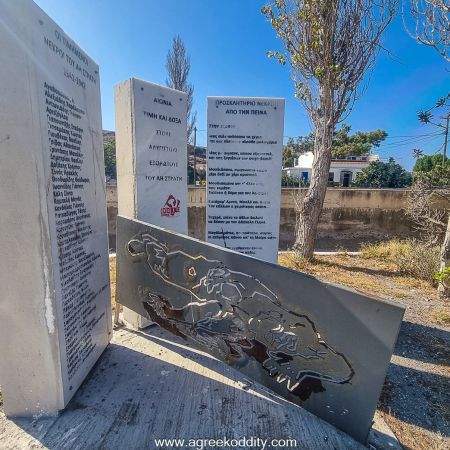
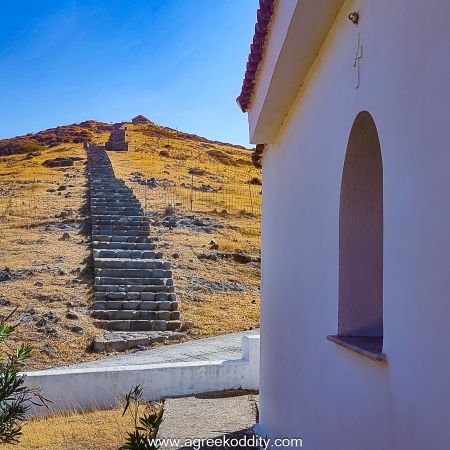



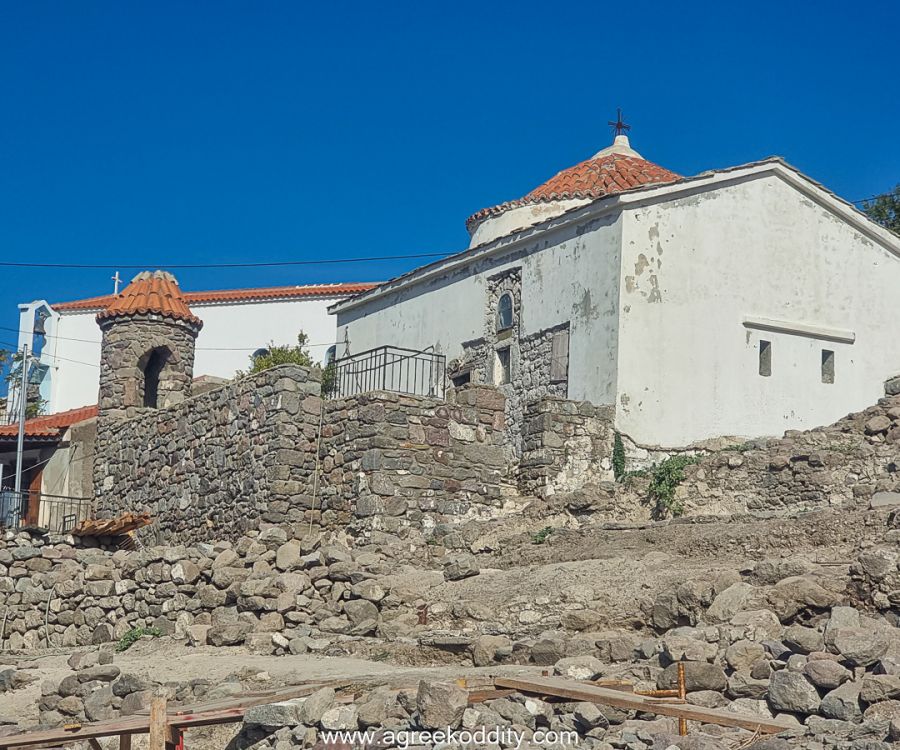
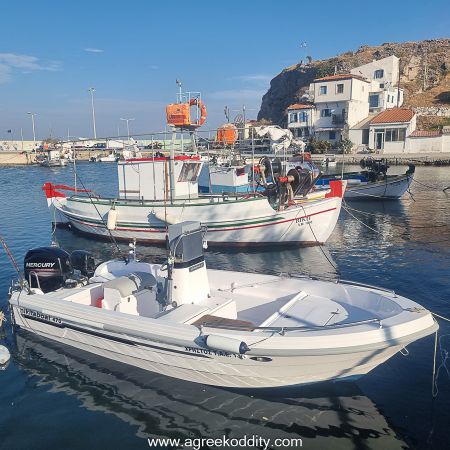


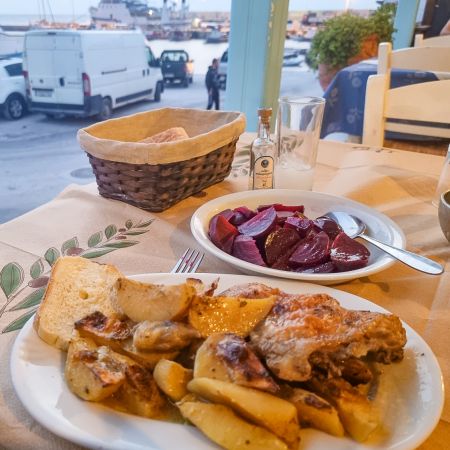





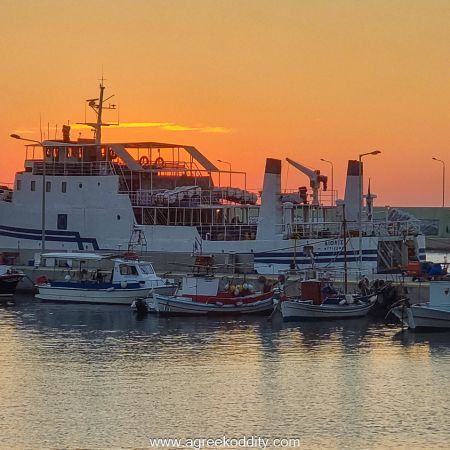
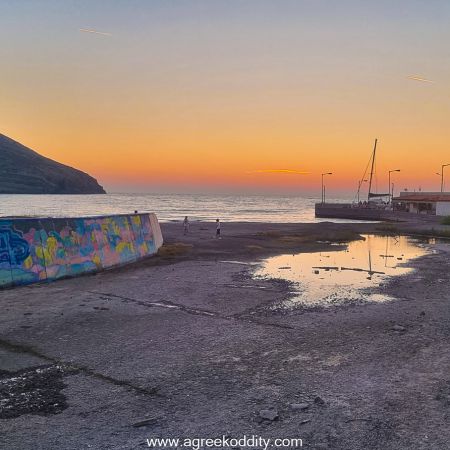









Hi Stephanie,
What a charming place Agios Efstratos is! I’ll bookmark this one, as it is my kind of place!
Cheers, Pat Durose
I’ve loved reading about this lovely island – definitely “Hidden Greece”!
Lovely Blogpost about one of the most secluded Islands of Greece. Thanks for sharing your Impressions. Many greetings from Tom & Ella (greece-monents)
Thank you Tom and Ella. Getting off the beaten track to the more secluded islands is always something that I’m keen to pursue! I’m glad that you liked the post! ❤